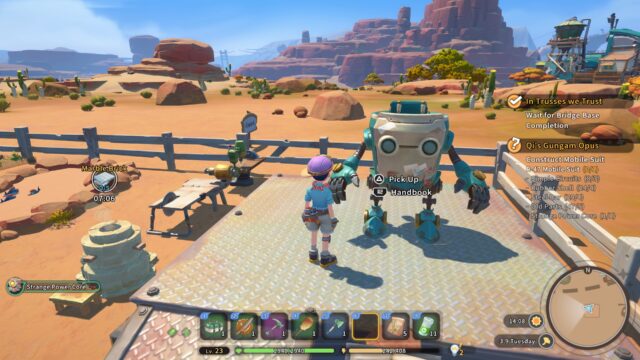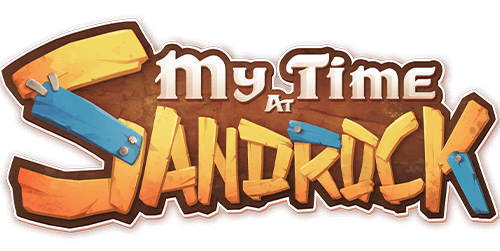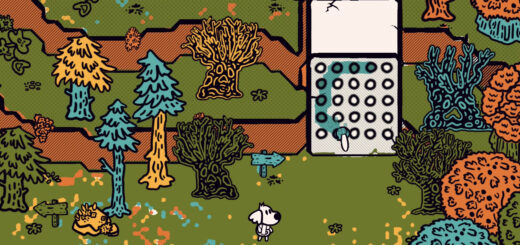My Time at Sandrock Review
Big Daddy Love Sponge
Pathea Games entered the ever more popular life sim genre in 2019 with the release of My Time in Portia. Over four years later, which includes plenty of time in Early Access, the studio has offered a follow-up in My Time at Sandrock. This second entry builds on the base and some of the lessons learned from its predecessor, although it doesn’t aim to strike out too far. While the game’s final third or so feels a bit lost in how to properly finish its lengthy campaign, a nonetheless addictive gameplay cycle peppered with plenty of feel good progression makes the time spent with it very enjoyable.
The game is set in the same world as and taking place roughly concurrently with the events in My Time at Portia, but players can readily leap into My Time at Sandrock as the stories are very much standalone. The series is set in a post-apocalyptic world that is well on its way to rebuilding, with the populace often able to make use of technological relics and resources left behind to help their lives and rebuilding efforts. Sandrock begins as a stagnant oasis town in the Eufala Desert, its situation and the ongoing desertification a result of overzealous resource use back in the town’s heyday. Players control one of two new builders recruited to replace the retiring Mason and to hopefully revitalise the town. This begins with solving some base repair and facility construction, like a new lift for the mines, before players eventually move on to tackle major issues such as its limited water supply and the hostile lizardfolk nearby.
The story does a good job introducing Sandrock’s situation. While there are some with hope for its future, many are whiling away the days until the time comes to pack up and leave. The player and fellow builder Mi-an’s impact is soon keenly felt, as the town steadily deals with its various issues. It’s certainly not plain sailing, as a wide variety of new crises and threats soon crop up, with players roped into helping the local Civil Corps deal with them thanks to their skill set and immense level of comparative competency. The main threat and excitement comes in around the two-thirds mark as the longer-running plot threads come to a head. After this is dealt with, however, the story rather loses its way and meanders to its ending as players run through the final set of projects, as ambitious as they may be, without much urgency.
Where My Time at Sandrock’s storytelling is at its most effective is bringing the game’s cast to life. The people of Sandrock are immensely likeable, and there’s a great variety to their personalities. Each of the characters have their own quirks and personal story lines that players can get involved with. One criticism on the line-to-line writing is that it is quite reliant on direct pop-culture references and quotes at times, but it can be forgiven as its used in a manner that at least feels consistent with the characters. Despite that, it’s usually a pleasure to spend time with and get to know Sandrock’s citizens, which makes its revitalisation all the more pleasing.
Dealing with many of these issues necessitates interacting with an underwhelming combat system. It’s a very straightforward action system with a selection of weapon types available. Players need to utilise a simple mixture of short combos, damage avoidance, and restorative items. It can be a bit frustrating early on, as the lack of decent feedback regarding both attack and defence can see players unexpectedly wiped out, but once players obtain some decent weaponry, it becomes largely trivial for the rest of the game. Combat feels like a quick means to an end rather than something designed to be what keeps players involved. There is some extra combat available, but soon enough there’s no need for players to actually engage with it as the useful items it rewards can be obtained in other manners, which is just as well as it’s simply not very fun.
Fortunately, combat is just a small part of My Time at Sandrock. The bulk of the game consists of completing missions by gathering resources to use back at the builder’s homestead just outside of town to use the base resources to create further ingredients, craft smaller items, and build larger projects. As the game goes on, players are able to expand their homestead and install more machines to create more ingredients and complete more advanced projects. It’s a thoroughly well realised cycle and the steady level of progress it offers, plus the wide variety of potential tasks that will help players down the line in one manner or another, ensures that very rarely does any time feel wasted.
There are plenty of different resources for players to obtain, and an assortment of ways to get hold of them. Many of the initial ingredients players need at the start come from scrap, stone, or the local plant life, with the most important tools being the player’s pickhammer and axe. Most of the scrap can be obtained by salvaging the things drug up by the local mining company, and while there are local laws against felling any trees, there’s enough other plant life to obtain any necessary items from those. As the game goes on, players will find new types of scrap that can be recycled into useful resources and also get the opportunity to directly go and mine the vital metallic ores that are needed for most of the building projects. This mining process also offers some fun exploration as players need to make their way down multiple floors in order to get at the different types of ore they need. Other items can be found by exploring the surrounding areas.
The building projects for players to undertake largely come from a mixture of main and side quests, though some will require players to go and upgrade their equipment first. This is done by supplying the local scientist Qi with enough data discs, most easily found in the general course of mining, to unlock those new machines that can create the parts needed for the project. Furnaces and recyclers are the most important machines for getting the base elements, while other machines turn things like metal bars into piping, gears, or plating or let players craft new equipment and gear. All of these processes work together wonderfully to create a strong and fully coherent pattern of using resources to generate ingredients necessary for the builder’s constructions or other necessary items.
As the game progresses, players are given opportunities to make their lives easier and keep things ticking along, such as putting in a standing order for a selection of scrap rather than having to obtain it themselves. In addition, players have a lot of ways to customise their own home. Decorations can be built and placed as they wish, along with any rooms or stories, many providing attributes bonuses as well as being there for the aesthetics. Alongside using their building tools and machines, players can also spend time farming and raising animals, which provides additional ingredients, albeit largely for optional content.

Players get to build a wide variety of things, some very impressive given the apparent resources at their disposal.
Building up relationships is another key part of My Time at Sandrock, and is built into the side quests system. Players can raise their relationships with the other townsfolk by talking to them, offering them gifts, hanging out in special event spots, and fulfilling various requests they make to the town’s commerce guild on a daily basis. Many of these requests can be fulfilled very quickly as players should be able to obtain more than enough resources over the natural course of the game. Raising relationships not only allows players to progress individual character quest lines, it also provides other in-game bonuses. The game naturally also features a selection of eligible bachelors and bachelorettes, and players can build up a romance, get married, and even start a family. However, certain characters are not available to fully romance until very late in the game, at which point the whole romance with them becomes a bit of a rushed afterthought. Sandrock has plenty of other side activities to get involved in, such as finding relics for the museum, plus its own set of festivals and events that the whole town turns out for.
My Time at Sandrock builds on the same graphical style as My Time at Portia and uses its character well. The locale certainly looks the part, with the dusty plains and rock formations peppered with appropriate flora, a sometimes curious mix of fauna, and a decent set of ruins to punctuate the post-apocalyptic world. The town itself is quite picturesque, and it’s nice to see all of the touches added as the builder accomplishes their various projects. However, many of the animations feel a bit lacking, and the game is also prone to a few hiccups. There were some bugs encountered during the game; nothing was gamebreaking or caused any major issues, but there were notably oddities, such as a character who had apparently left still wandering around town as normal. On the audio front, the game’s music is largely enjoyable to listen to and helps instill Sandrock’s character, but the voice acting is much more variable. Justice and Cooper fulfill their — largely comic — roles very well, but a lot of the other voice acting sounds stilted.
My Time at Sandrock certainly doesn’t skimp on the content, with players able to expect at least a hundred hours before they hit the credits. It uses those hours well enough, with an absorbing gameplay loop that always gives players the feeling that they are progressing in one manner or another, even when it might be categorisable as busywork. Despite a weaker presentation than contemporary titles and a last third that meanders without the urgency of what came before, the game is a pleasing experience and one that those with even just a passing interest in the life and crafting sim genre are likely to enjoy their time with.


Highly enjoyable gameplay cycle
Imparts strong sense of progression
Likeable cast of characters
Last parts of the story meander along without urgency
Nothing gamebreaking, but a few odd bugs
Combat is very uninspiring








Recent Comments